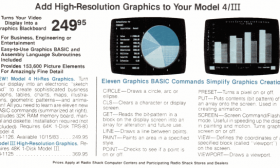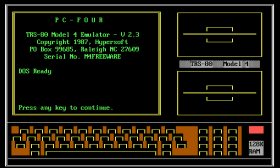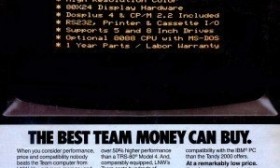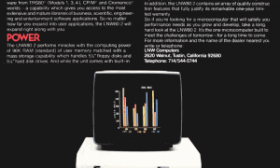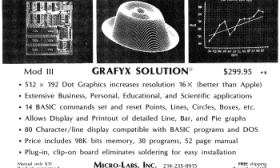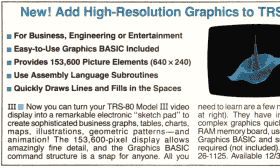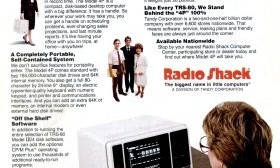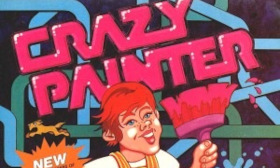Radio Shack introduced the TRS-80 Microcomputer System, later known as the Model I, in August 1977. It was the first member of the original line of TRS-80 computers. Radio Shack followed the Model I with the mostly compatible Model III in 1980 and then the Model 4 in April 1983. But other than the transportable Model 4P in November 1983 and the improved Model 4D in 1985, there were no further members of this computer family.
Around the time of the development of the Model 4, Radio Shack engineers did plan a computer that could have followed it. Although not known by the name within Radio Shack, this often rumored computer was usually called the “Model 5” or the “Model 4C” by the public.
By considering all of the available bits of information, it is possible to piece together details about the key features of the “Model 5”:
(Read more...)
Radio Shack introduced their high-resolution add-on for the Model 4 (catalog number 26-1126) on October 15, 1983. Just like their Model III high-resolution board, it was never identified by name in any Radio Shack catalog. The official name seems to have been “TRS-80 Model 4 Computer Graphics” but it was usually referred to as the “Radio Shack Model 4 high-resolution board.”
At $249.95, the Model 4 high-resolution board was $80 cheaper than the Model III version. It provided a nearly identical hardware interface to the Model III version, with the same 640 by 240 resolution. It’s interesting to note that the Macintosh screen at the time was 576 by 340.
(Read more...)
PC-Four was the first TRS-80 Model 4 emulator for IBM PC compatible computers. It was written by Michael Gingell and introduced by Hypersoft in mid-1987 for a price of $79.95. PC-Four required a computer with at least 384K of memory and worked on both floppy and hard drive systems.
PC-Four (sometimes referred to as PC4) was quite different than later TRS-80 emulators. It achieved most of its compatibility not through Model 4 hardware emulation but by emulating the Model 4 operating system. This approach (similar to the MS-DOS emulator DOSBox today) allowed PC-Four to approximate Model 4 speed when running on a Tandy 1000 SX. The PC-Four manual described it this way:
(Read more...)
The LNW Team was an intriguing idea for a computer to bridge the TRS-80 and MS-DOS worlds. It was sold by LNW Computers, the company responsible for the LNW System Expansion, the LNW80, and the LNW80 Model 2.
The computer appears to have been the same externally as the LNW80 Model 2, although the standard memory was increased to 160K and the clock speed increased to 5.3 MHz. What really set the LNW Team apart was the optional 8088 board.
(Read more...)
One of the biggest weaknesses of the TRS-80 Model I was the lack of lowercase characters on the screen. Although that omission was hardly unique to the Model I (many computers at the time lacked lowercase, including the Apple II), it was still a notable limitation that affected many applications, especially word processing.
The two people most responsible for the Model I (originally known as the Radio Shack TRS-80 Microcomputer System) were Don French and Steve Leininger. Don French, described as “the originator of the TRS-80 project,” was a buyer for Radio Shack who had long pushed for Radio Shack to manufacture a microcomputer. Steve Leininger was the engineer who designed almost all of the hardware of the Model I and created the original Level I BASIC.
Steve Leininger mentioned lowercase in a talk he gave to the San Diego Computer Society in September 1977, just one month after the TRS-80 was introduced:
(Read more...)
The LNW80 Model 2, sometimes referred to as the LNW80/2, was a TRS-80 compatible computer sold by LNW Computers (formerly LNW Research Corporation). Introduced in late 1982 for a price of $2695, the LNW80 Model 2 was an upgrade to the original LNW80. The LNW80 Model 2 provided nearly complete compatibility with the TRS-80 Model I but added many new features and enhancements. In addition to being available through direct sales or through dealers in the United States, the LNW80 Model 2 was also sold in Australia and New Zealand through Micro-80 magazine.
Unlike the earlier LNW80, the LNW80 Model 2 was only sold as a complete computer, not as a “semi-kit.” It was enclosed in a very sturdy (and heavy) steel case which featured an enhanced keyboard. The keyboard had several extra keys not found on a TRS-80 Model I, including CONTROL, CAPS LOCK, and two function keys (F1 and F2). There were also dual reset keys (one on each side of the keyboard) that would reset the computer when pressed simultaneously.
(Read more...)
The Model III Grafyx Solution was a high-resolution graphics add-on for the TRS-80 Model III. Created by Ted Carter, president of Micro-Labs, the Grafyx Solution was introduced in early 1982 for a price of $299.95. There never was a Model I version of the Grafyx Solution.
The Model III Grafyx Solution used a different approach than 80-GRAFIX, an earlier Micro-Labs product for the Model I and III. While 80-GRAFIX could only simulate high-resolution graphics by redefining the character set, the Grafyx Solution provided full access to the 512 by 192 resolution of the Model III.
No soldering was required to install the Grafyx Solution. Instead, installation consisted of plugging the Grafyx Solution into the Model III and using special micro-clips to attach it to specific pins on chips already in the Model III.
(Read more...)
Radio Shack introduced their high-resolution add-on for the Model III (catalog number 26-1125) on December 30, 1982 for a price of $369.95. It was never identified by name in any Radio Shack catalog but the official name seems to have been “TRS-80 Computer Graphics Package.” Few ever used that name and it was commonly referred to as the “Radio Shack high-resolution board.”
The Model III high-resolution board offered a resolution of 640 by 240. This was the same resolution as the Model II high-resolution add-on that Radio Shack had introduced the previous year, but it was higher than the normal Model III resolution of 512 by 192. There were so many similarities to the Model II high-resolution add-on that I suspect it was the basis for the Model III version.
(Read more...)
The TRS-80 Model 4P (catalog number 26-1080) was a transportable version of the TRS-80 Model 4, released on November 15, 1983 for a starting price of $1799. This was $200 less than the price of a desktop Model 4 and $200 more than its nearest competitor, the transportable Kaypro II.
Advertised as “a microcomputer worth carrying about” the Model 4P was introduced this way in a 1984 Radio Shack catalog:
Now get the versatility of our popular TRS-80 Model 4 desktop computer in a compact system you can take anywhere! The Model 4P is easy to carry—and it’s small enough to stow in overhead luggage racks on planes, trains, or buses. It’s the perfect computer for our mobile society!
(Read more...)
Crazy Painter qualifies as one of the few completely unique TRS-80 games. It was written by Robert Pappas, author of the TRS-80 games Frogger and Bounceoids. Crazy Painter was released by the Cornsoft Group in 1982. In addition to the TRS-80 version, the Cornsoft Group also released a version of Crazy Painter in 1983, written by Charles Guy, for the TRS-80 Color Computer. But there was no connection to the 1983 BBC Micro game named Crazy Painter, which was sold by Superior Software.
The goal in Crazy Painter is to completely fill the screen using a paint roller. This is a lot harder than it sounds because various obstacles, including roaming dogs and snakes, show up to ruin what you have already painted and hinder your efforts. Unlike most other arcade style games at the time, Crazy Painter is completely non-violent (unless you consider painting to be violent).
(Read more...)
